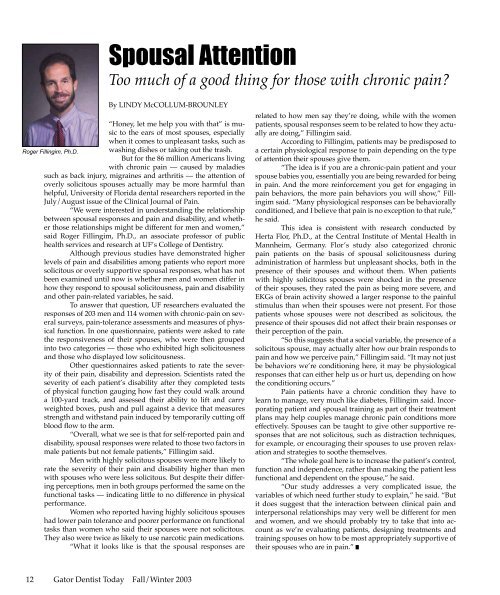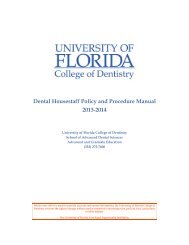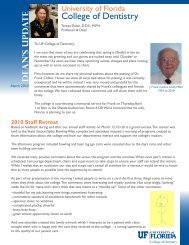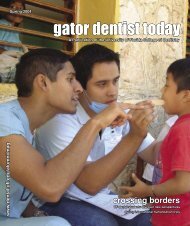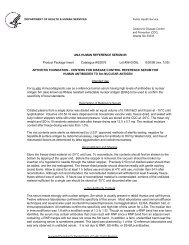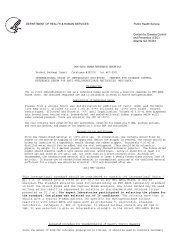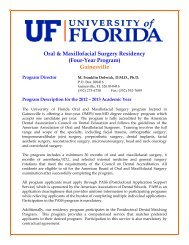gator dentist today - College of Dentistry - University of Florida
gator dentist today - College of Dentistry - University of Florida
gator dentist today - College of Dentistry - University of Florida
You also want an ePaper? Increase the reach of your titles
YUMPU automatically turns print PDFs into web optimized ePapers that Google loves.
Spousal Attention<br />
Too much <strong>of</strong> a good thing for those with chronic pain?<br />
By LINDY McCOLLUM-BROUNLEY<br />
“Honey, let me help you with that” is music<br />
to the ears <strong>of</strong> most spouses, especially<br />
when it comes to unpleasant tasks, such as<br />
Roger Fillingim, Ph.D.<br />
washing dishes or taking out the trash.<br />
But for the 86 million Americans living<br />
with chronic pain — caused by maladies<br />
such as back injury, migraines and arthritis — the attention <strong>of</strong><br />
overly solicitous spouses actually may be more harmful than<br />
helpful, <strong>University</strong> <strong>of</strong> <strong>Florida</strong> dental researchers reported in the<br />
July/August issue <strong>of</strong> the Clinical Journal <strong>of</strong> Pain.<br />
“We were interested in understanding the relationship<br />
between spousal responses and pain and disability, and whether<br />
those relationships might be different for men and women,”<br />
said Roger Fillingim, Ph.D., an associate pr<strong>of</strong>essor <strong>of</strong> public<br />
health services and research at UF’s <strong>College</strong> <strong>of</strong> <strong>Dentistry</strong>.<br />
Although previous studies have demonstrated higher<br />
levels <strong>of</strong> pain and disabilities among patients who report more<br />
solicitous or overly supportive spousal responses, what has not<br />
been examined until now is whether men and women differ in<br />
how they respond to spousal solicitousness, pain and disability<br />
and other pain-related variables, he said.<br />
To answer that question, UF researchers evaluated the<br />
responses <strong>of</strong> 203 men and 114 women with chronic-pain on several<br />
surveys, pain-tolerance assessments and measures <strong>of</strong> physical<br />
function. In one questionnaire, patients were asked to rate<br />
the responsiveness <strong>of</strong> their spouses, who were then grouped<br />
into two categories — those who exhibited high solicitousness<br />
and those who displayed low solicitousness.<br />
Other questionnaires asked patients to rate the severity<br />
<strong>of</strong> their pain, disability and depression. Scientists rated the<br />
severity <strong>of</strong> each patient’s disability after they completed tests<br />
<strong>of</strong> physical function gauging how fast they could walk around<br />
a 100-yard track, and assessed their ability to lift and carry<br />
weighted boxes, push and pull against a device that measures<br />
strength and withstand pain induced by temporarily cutting <strong>of</strong>f<br />
blood flow to the arm.<br />
“Overall, what we see is that for self-reported pain and<br />
disability, spousal responses were related to those two factors in<br />
male patients but not female patients,” Fillingim said.<br />
Men with highly solicitous spouses were more likely to<br />
rate the severity <strong>of</strong> their pain and disability higher than men<br />
with spouses who were less solicitous. But despite their differing<br />
perceptions, men in both groups performed the same on the<br />
functional tasks — indicating little to no difference in physical<br />
performance.<br />
Women who reported having highly solicitous spouses<br />
had lower pain tolerance and poorer performance on functional<br />
tasks than women who said their spouses were not solicitous.<br />
They also were twice as likely to use narcotic pain medications.<br />
“What it looks like is that the spousal responses are<br />
12 Gator Dentist Today Fall/Winter 2003<br />
related to how men say they’re doing, while with the women<br />
patients, spousal responses seem to be related to how they actually<br />
are doing,” Fillingim said.<br />
According to Fillingim, patients may be predisposed to<br />
a certain physiological response to pain depending on the type<br />
<strong>of</strong> attention their spouses give them.<br />
“The idea is if you are a chronic-pain patient and your<br />
spouse babies you, essentially you are being rewarded for being<br />
in pain. And the more reinforcement you get for engaging in<br />
pain behaviors, the more pain behaviors you will show,” Fillingim<br />
said. “Many physiological responses can be behaviorally<br />
conditioned, and I believe that pain is no exception to that rule,”<br />
he said.<br />
This idea is consistent with research conducted by<br />
Herta Flor, Ph.D., at the Central Institute <strong>of</strong> Mental Health in<br />
Mannheim, Germany. Flor’s study also categorized chronic<br />
pain patients on the basis <strong>of</strong> spousal solicitousness during<br />
administration <strong>of</strong> harmless but unpleasant shocks, both in the<br />
presence <strong>of</strong> their spouses and without them. When patients<br />
with highly solicitous spouses were shocked in the presence<br />
<strong>of</strong> their spouses, they rated the pain as being more severe, and<br />
EKGs <strong>of</strong> brain activity showed a larger response to the painful<br />
stimulus than when their spouses were not present. For those<br />
patients whose spouses were not described as solicitous, the<br />
presence <strong>of</strong> their spouses did not affect their brain responses or<br />
their perception <strong>of</strong> the pain.<br />
“So this suggests that a social variable, the presence <strong>of</strong> a<br />
solicitous spouse, may actually alter how our brain responds to<br />
pain and how we perceive pain,” Fillingim said. “It may not just<br />
be behaviors we’re conditioning here, it may be physiological<br />
responses that can either help us or hurt us, depending on how<br />
the conditioning occurs.”<br />
Pain patients have a chronic condition they have to<br />
learn to manage, very much like diabetes, Fillingim said. Incorporating<br />
patient and spousal training as part <strong>of</strong> their treatment<br />
plans may help couples manage chronic pain conditions more<br />
effectively. Spouses can be taught to give other supportive responses<br />
that are not solicitous, such as distraction techniques,<br />
for example, or encouraging their spouses to use proven relaxation<br />
and strategies to soothe themselves.<br />
“The whole goal here is to increase the patient’s control,<br />
function and independence, rather than making the patient less<br />
functional and dependent on the spouse,” he said.<br />
“Our study addresses a very complicated issue, the<br />
variables <strong>of</strong> which need further study to explain,” he said. “But<br />
it does suggest that the interaction between clinical pain and<br />
interpersonal relationships may very well be different for men<br />
and women, and we should probably try to take that into account<br />
as we’re evaluating patients, designing treatments and<br />
training spouses on how to be most appropriately supportive <strong>of</strong><br />
their spouses who are in pain.”


